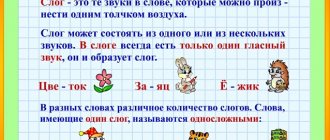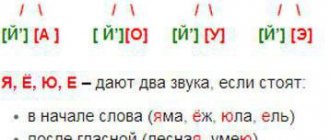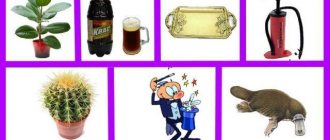Syllables are the parts into which a word is divided during oral speech. When we pronounce a word, we get several exhalation pushes of air - this is exactly the pronunciation by syllables: cat. Two pushes of air when exhaling - two syllables: vo-da. 3 puffs of air - three syllables: na-u-ka.
A word has the same number of syllables as there are sounds from the voice, that is, vowels: sheet - 1 syllable, no-ra - 2 syllables. A syllable can have a very different number of letters, but one must be a vowel.
A word can have a different number of syllables. There are one-syllable, two-syllable, three-syllable words and polysyllabic words: leaf (1 syllable), no-ra (two-syllable word), u-e-zhat (three-syllable).
A syllable can consist of one vowel sound or a combination of a vowel and a consonant: a-ba-zhur. Even one vowel sound is already a syllable. But one consonant is not a syllable. How to divide a word into syllables? It is important to understand the main principle: if a syllable includes a vowel and a consonant, then it always begins with a consonant: no-chnik, country.
Monosyllabic words
Based on the minimum number of vowels in a word, we select monosyllabic words that contain one phonetic syllable. Let's remember what a phonetic syllable is.
Definition
A phonetic syllable is one vowel sound or a vowel combined with one or more consonant sounds, which in the process of speaking are pronounced with one impulse of exhaled air.
Place your palm under your chin and clearly pronounce the words:
laz, march, elk, bridge, leaf, moment, cheese, test, look
On vowels, the chin will hit the palm once. This means that these words are monosyllabic.
Additional material
Let's learn in more detail about the composition of monosyllabic words with one, two, three, four consonants.
A selection of collages from 1 to 8 type of syllable structure of the word
Type 1: two-syllable words Vocabulary: summer, sky, clouds, hut, willow, puma, fly, wasp, fly, goat, pony, water, mud, toad, children, Vanya, Nata, saw, magnifying glass, cotton wool, owl, notes , leg(s), paw(s), vase, perfume, udder, horns, ear(s), hand(s).
Type 2: three-syllable words made from open syllables Dictionary: Polina, spiders, Panama hat, lipstick, bouquets (lilies, irises), newspaper, coins, macaque, honey mushrooms, raspberries, bananas, dishes, milk, lemons, loaves, vegetables, tomatoes, irons , ducklings, boots, cubes, car, cabin, wheels, brooms, kittens, dog, berries, raspberries.
Type 3: monosyllabic words Dictionary: Grandfather, night, forest, cat, bull, horse, juice, soup, cancer, poppy, oak, house, goose, fluff, ball, mouse, tank, beetle, moss, stump, hedgehog, elk , whale, cheese, onion, knife, tea, honey, horn.
Type 4: two-syllable words with a closed syllable Dictionary: Ivan, ottoman, puppy, medal, fireplace, fire, castle, boar, torch, sunset, hammock, runner, sock, ticket, rope, rooster, python, hamster, buffet, can, spider, bouquet, banana, loaf, lemon, coconut, broom, dustpan, raccoon, sofa, package, sack, swan.
Type 5: two-syllable words with a cluster of consonants in the middle Dictionary: Olga, skirt, T-shirt, slippers, bows, bucket, sponge, stain, shelves, barrel, jar, oil, cherry, pumpkin, mice, cat, bowls, window, pine, branch, pine cone, lamp, letter, pen, waffles, cup, palm tree, flowerpot, watering can, duck, cabinet, bear, hat, thread, doll.
Type 6: two-syllable words made from closed syllables Dictionary: Pavlik, Anton, cactus, pot, balcony, tray, jug, compote, omelet, broth, teapot, tulip, turkey, worm, fountain, dolphin, bear, trap, bunny, spruce forest, forester (Maxim), bulldog, umbrella, rain, peacock, chestnut, chest, magnet, pearls, compass, donut, cog.
Type 7: three-syllable words with a closed syllable Vocabulary: airplane, parachute, steam locomotive, bell, rhinoceros, hippopotamus, calf, vegetable garden, squash, zucchini, tomato, cucumber, duckling, ant, mantis, diver, fisherman, pelican, whale, captain, parrot, steamboat, telephone, suitcase, kitten, mouse, waterfall, little fox, hedgehog, elk calf, owlet, nightingale, sparrow, lumberjack, boletus. Possible names: Nikolai, Elisha, Timofey, Seraphim.
Type 8 SSS: three-syllable words with a combination of consonants Dictionary: village, grandmother, grandfather, grandchildren, girl, Tanechka, bun, slippers, Vanechka, shirt, cap, popsicle, gazebo, bagels, tree, Christmas tree, needles, cones, lilies of the valley, frog , sparrows, hen, chickens, apple tree, apples, bug, daisies, butterfly, cuckoo, tureen, sausages, plate, salt shaker, cabbage, snail, ladder, fishing rod, bench, oyster mushrooms, basket, berries, blueberries.
Two-syllable words
According to the number of syllables, words can be polysyllabic: two-, three-, four-syllable, etc.
Two-syllable words, as can be determined by their name, contain two vowel sounds.
Examples
sli-va, chair-chick, fence, city, kro-na, te-ma, u-kaz, island, a-gent, i-gla, snake-ya, evening
When pronouncing them, the chin will fall onto the palm twice, as there will be two shocks of exhaled air.
Additional material
We will learn about how to divide words into phonetic syllables and what needs to be taken into account with examples in the article about two-syllable words.
Not all two-syllable words can be transferred from one line to another in accordance with phonetic syllable division. A number of words in which a single vowel forms an independent syllable cannot be transferred, leaving one letter on the line, for example:
- snake-me - snake
- u-dar - blow
- o-braz - image
- i-gla - needle
- a-nis - anise.
Why be able to divide a word into syllables?
Isolation of syllables is important for the correct hyphenation of words; the syllabic principle is the main one in competent hyphenation, although not the only one. Both skills are important: identifying syllables in a word and the ability to find morphemes (meaningful parts of a word), because syllables and morphemes in many cases do not coincide. The syllable is not a prefix or root, or a suffix.
Division into syllables occurs when a word is pronounced. And dividing a word into parts is necessary for writing a word, that is, for writing letters in prefixes, roots, and suffixes.
Isolation of morphemes (prefixes, suffixes, roots) and syllables are two different actions, two different principles on the basis of which competent transfer of words is carried out.
For example, when transferring a word syllable by syllable, you need to simultaneously see the root and prefix, so that, for example, you do not tear off the first and last letter of the root or break a monosyllabic prefix.
There are a number of transfer rules that rely on the ability to divide a word into syllables and morphemes at the same time. Therefore, you need to be able to do one and the other.
Three-syllable words
A word can have more vowels than two. Three vowel sounds combined with consonants form three-syllable words. When pronouncing a three-syllable word, three impulses of air occur, but one of them is stronger, which is created by the stressed vowel, and two are weaker in unstressed syllables. Let's make sure of this by saying the words:
let-tchi-tsa, ko-ro-va, be-know
Examples of three-syllable words
In three-syllable words, consonants are grouped with vowels with two, three or even four sounds per syllable, for example:
- do-ro-ga, bo-ro-da, so-ro-ka;
- pri-sta-vka, kra-so-ta, te-le-fon, ka-ran-dash, bu-ma-zhka;
- jump up, shake up, jump up, wait, look.
A vowel can form an independent syllable in a three-syllable word:
- a-ktri-sa, a-zbu-ka, a-na-us, a-ra-his;
- o-city, o-val-ny, o-fresh-to-live, o-tli-chnik;
- u-gol-nik, u-ra-gan, u-chi-tel, u-slit.
Please note that the orthographic transfer of the words given above does not coincide with their syllable division due to the presence of a single vowel in their sound composition.
Additional material
Let's learn the rule of word hyphenation in Russian.
Let's compare phonetic syllable division and orthographic hyphenation of words:
| Phonetic syllable division | Spelling hyphenation |
| u-gap-e | gorge |
| garden | garden |
| o-tli-chnik | personal name |
| ABC | ABC |
| Hurricane | Hurricane |
| destination | destination |
How to divide a word into syllables with a combination of consonants
How to divide a word into syllables if there are several consonants nearby in the middle? How to correctly break a word into syllables: cat or cat? You need to understand the principle of so-called greater sonority. It is observed in the second case. From consonant to vowel. First there is a dull sound, then a voiced consonant, and at the end a vowel - shka. The first syllable ends with a vowel (ko). Such syllables are called open. We have much more of them than those that end with consonants: table, chair (they are called closed syllables).
In the middle of a word, the syllable is usually open, that is, it ends with a vowel sound: stra-na. According to the principle of increasing sonority, all consonants move in most cases to the subsequent syllable: cat.
If several consonants are combined in the middle of a word, then all the consonants following the vowel go to the next syllable: o-flow. These can be the same consonants or simply combinations of different consonants: o-flow, sha-pka, ko-shka.
An exception to this point: only those syllables in the middle of a word that end with unpaired consonant voiced sounds (they are called very voiced, sonorant) end with a consonant: [й], [р], [р'], [л], [л '], [m], [m'], [n], [n']: may-ka, San-ka, man-ka.
If in a word several sounds merge into one sound, then they all go to one syllable: zhu-zhzh (Zh)at, distracted (CA). In these cases, one should not confuse division into syllables and morphemic division for transferring a word: for example, we divide o-teket by syllables, but for transfer we divide the same word like this - ot-tek.
Games with syllables
Learning to read can be made fun and colorful by using various games with syllables.
Find out the syllable type.
In this game, you can ask children to find an open and closed syllable from those proposed. The game is good for children who are preparing for school, can read and imagine what an open and/or closed syllable is.
For example, in the word “dangerous” (o-pas-no-e) there are 3 open and 1 closed syllables.
Find the syllable in the word.
Define some simple syllable for the games, for example, “KO”. Arrange a competition with your child to see who can name the most words with this syllable.
For example, CAT, COW, COM, GOAT, etc.
This way you will teach your child to visually identify the letter composition of a word.
Which word has three syllables.
This game involves the ability to divide words into syllables for reading and count their number. Ask your child to name which word has three syllables, which has five, etc. To do this, the baby will have to work hard to divide words into syllables in order to find out how many syllables are in a word.
For example, the word “go-ro-shi-na” has 4 syllables, and the word “mo-ro-zhe-no-e” has 5 syllables.
Let's play word creation.
Creating new words is also fun. Try to take several syllables from different words and independently come up with a new word from them (make sure that the child does not invent non-existent words, but relies on meanings or vocabulary that already exist in the language). Ask to name the types of syllables in a word.
Which of the proposed syllables comes first in the words.
For this game, take several three- or four-syllable words (for example, cat, dog, dangerous, orange). You can use pictures to indicate them if the child still doesn’t read well. Write out the syllables randomly. Then ask your child to name the words presented in the pictures and name the first syllables in them.
Which letter goes where.
This game is based on a technique proposed by speech therapist Nadezhda Zhukova and presented in her textbook for children “A Primer”. If you do not have this book, you can master this technique yourself.
Its meaning is to clearly show the child the principle of reading using syllables as an example.
Take a syllable, divide it into letters and draw them on opposite ends of the sheet. From one letter to another, draw or glue a running man. Any toy that the baby will lead from one letter to another is suitable for this purpose. In this case, the sounds of the syllable are called, smoothly flowing into each other. Use an open syllable to play.
The second version of this game. Draw the initial letters of the syllable in capitals at some distance from each other. From them, roughly draw two lines in the form of a wedge and along them write several vowels from the syllable, gradually reducing them in size and then increasing them. Then ask your child to read what is written. He must extend the vowel sound in the syllable. Thus, the child learns that the base of a syllable is a vowel sound.
Syllabic coloring pages.
All children love to color. But the tasks here are unusual. The picture, like a puzzle, is drawn into separate parts, in which syllables of the same consonant are randomly written, for example: MA, MO, MU, WE, MI, ME, etc. Each syllable has its own color. If the child reads the syllables correctly and colors them, he will receive a color picture. This is how we teach the baby to independently find the necessary syllables.
There are a lot of similar games that can be offered. You can come up with them yourself in the process of teaching your child to read and divide words into syllables, memorizing the types of syllables. Remember that the main thing is to make reading interesting, then the books will later seem like a real magical world!
The principle of dividing words into syllables
If you remember the curriculum in primary school, then a rule will arise in your memory: the number of vowels in a word, the number of syllables .
Therefore, to visually determine the number of syllables, you need to count the vowels. What letters do we classify as vowels? There are 10 vowel letters in the alphabet:
- A, O, U, Y, I, E - indicate one sound;
- E, E, YU, I – indicate two sounds (E=Y+E; E=Y+O; Y=Y+U; I=Y+A).
Let’s take the word “dangerous” as an example and divide it into syllables:
Dangerous=o-pass-no-e (4 syllables).
In this case, we simply divided the word into syllables based on the number of vowels. However, if the same word needed to be moved from one line to another, the division principle would be different (you cannot move one letter to another line):
Dangerous=dangerous – division of a word for hyphenation.
So, in order to correctly determine the number of syllables, the child needs to learn vowels.







